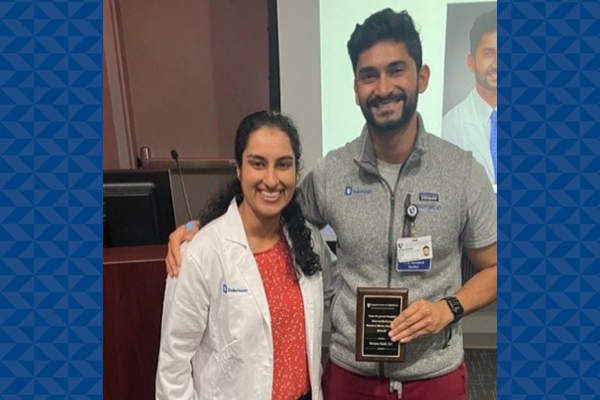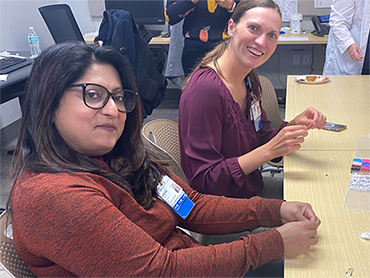
Hospitals increasingly rely on performance metrics such as length of stay, readmission rates, case mix index (CMI), and discharge documentation accuracy to evaluate institutional performance.
These metrics and others like quality care improvement, regulatory requirements, and financial sustainability also directly affect reimbursement and patient outcomes, playing a central role in hospital operations. Yet many medical trainees receive limited formal education on how their daily actions influence such outcomes, health care systems and patient care.
Residents are bridging this gap — a shortfall recognized by the Accreditation Council for Graduate Medical Education which has designated Systems-Based Practice (SBP) as one of six core competencies for graduate medical education — in the Duke Internal Medicine Residency Program.
Increasing Awareness
Drs. Akhila Belur, John Hoyle, Komal Safdar, and Pahresah Roomiany developed a structured weekly huddle at Duke Regional Hospital (DRH) held during the DRH general medicine rotation to introduce SBP concepts and increase awareness of how the daily work of residents impacts the health care system and patient care.

“As physicians, our primary motivation for entering medicine is to care for patients,” said Dr. Safdar, DRH internal medicine chief resident, ambulatory medicine. “Accordingly, our education focuses on mastering the complexities of medical science and delivering high-quality care. Meanwhile, hospitals and health systems are increasingly assessed based on performance metrics. Organizations like the Centers for Medicare & Medicaid Services and The Joint Commission have established standardized measures to promote consistency across institutions.”
In post-session surveys and informal interviews, learners described the huddles as “illuminating,” “relevant,” and “one of the few times we talk about what happens after we write a note.”
Throughout the academic year, four metrics for senior residents who rotate at Duke Regional Hospital were tracked including CMI, completion of discharge summaries in 24 hours, hospital follow-up appointment within 7 days, and readmission rates.
To boost resident engagement and bring energy to what can be a traditionally “dry” topic, the residents turned the initiative into a friendly annual competition.
New Resident Metric Champion
This year’s Resident Metric Champion is Dr. Sanjay Gadi, who demonstrated outstanding performance on all four metrics, which drive the use of specific note templates, order sets, and dot phrases in the electronic health record.
When documentation is incomplete or unclear, attending physicians are often asked to revise notes or update patient status to accurately reflect the care provided. While trainees may not witness these backend adjustments, they will be responsible for them once they complete their training.
“By introducing performance metrics during residency, residents better understand the rationale behind standardized documentation and its role in hospital evaluations, ultimately, supporting the delivery of high-quality patient care in today’s data-driven healthcare environment,” Dr. Safdar added.
Each week, the huddle is brought together by the DRH internal medicine chief resident and attended by medical students, interns, residents, and attending physicians who are part of hospital leadership to foster a shared understanding of SBP and operational challenges.
The huddle lasts 15-20 minutes and is composed of three parts. First, is an open forum where residents and students can raise workflow barriers, ask questions, and propose solutions. Secondly, they review resident metric data and review the winners from the previous month on four hospital performance metrics relevant to the teaching teams.
Lastly, the residents have a rotating schedule of four 10-minute mini-lectures covering foundational systems-based practice topics covering Clinical Documentation Improvement (CDI), Diagnosis-Related Groups (DRGs) and Relative Weight, Case Mix Index (CMI), Observation vs. Inpatient Status, and Core Measures.
Drs. Rachel Hughes and Eleni Boussios created the curriculum content, and Dr. Tamara Mueller extracted the resident metric data. The Duke Clinical Documentation Integrity team, Christine Britland, Tricia McGinn and Debbie Squatriglia also contributed to the initiative.